3 methods that treat permanent foot warts that are simple
- 8 abnormal signs on the skin warning the body is having serious health problems
- 11 most common misunderstandings that billions of people around the world still believe
- 10 great uses of Aspirin may not be known
Warts are benign, small-sized tumors that develop on the skin caused by Human Papillomavirus or HPV ( one of the sexually transmitted viruses ).
Warts grow on the soles of the feet that are uncomfortable while walking, like having stones in shoes. Warts often appear on the soles of the feet where the pressure is the most, making the warts appear flat but deep under the skin.
Most cases of foot warts do not require care or treatment from a doctor. You can treat and prevent warts from growing back in just a few simple steps that can be done at home. Here are 3 permanent foot warts treatments that are simple . Invite you to consult!
Method 1: Treat foot warts at home
1. Identify restrictions on materials at home

Although treating foot warts at home is effective, it will take longer. If you want your warts to disappear quickly, it's best to see a doctor. However, permanent wart removal also takes time, even when treated by a doctor.
- Foot warts often disappear and leave no scars but it takes several months. Besides, warts can be painful and make it difficult to move.
2. Prepare before treating foot warts

First, soften the warts head by soaking your feet in warm water for a few minutes. Then, use pumice stone or nail file to sharpen the skin on the warts.
- Note: do not use pumice stone or file nails to rub the wart to rub on other parts of the body to avoid spreading the virus.
- Grinding the dead skin above will help the treatment material penetrate deeper into the wart.
3. Use salicylic acid
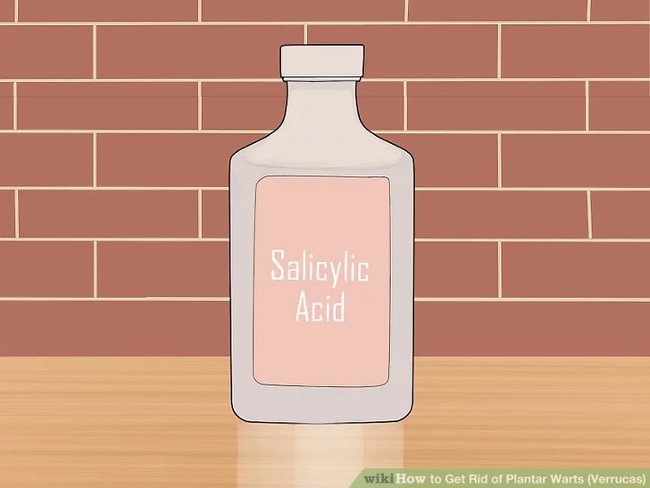
Currently, there are many over-the-counter products used directly on the skin like Compound W to treat foot warts with salicylic acid. The product is in liquid form, gel or patch. Remember to follow the instructions on the package to successfully remove warts.
- Treatment with salicylic acid does not cause pain but it will take a few weeks to produce results.
4. Use duct tape
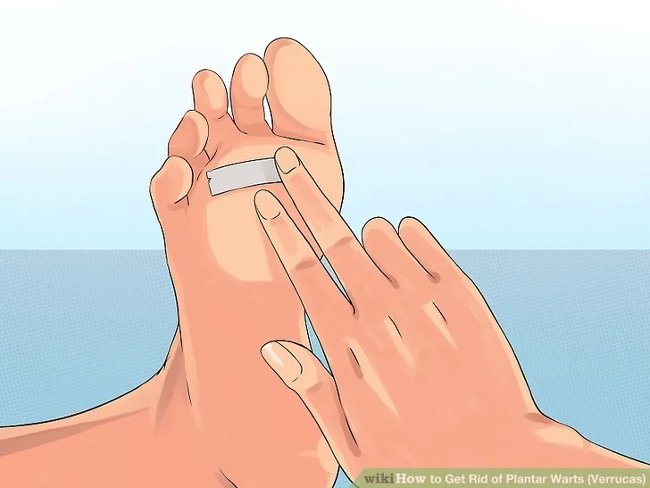
Cut the tape according to the size of the warts and paste it on the wart for up to 6 days. On the 7th day, remove the bandage and soak your feet in warm water for about 5 minutes to soften dead skin on warts. Then, use pumice stone or nail file to sharpen the skin on the wart, replace the new bandage and tape it 6 days later.
- Do not use pumice stone or nail files that have been wiped for other purposes.
- The treatment process may take several weeks to be effective.
- Although this mechanism of operation has not been determined, many people said that this method brought good results.
5. Research frozen compounds at home
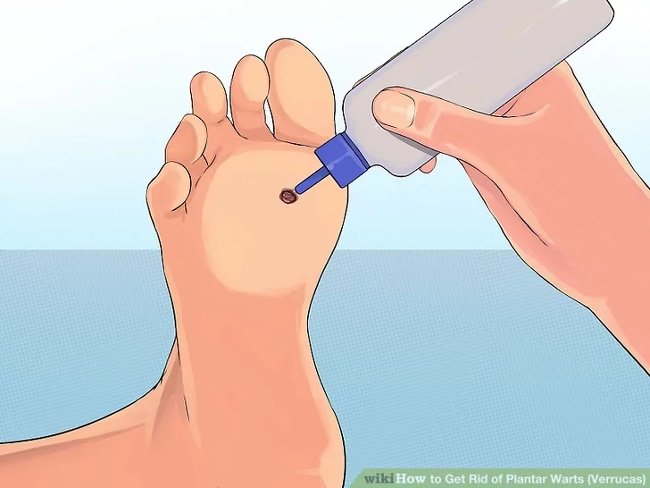
The freezing process will reduce blood circulation to warts. Currently, there are many over-the-counter medicines that can be used at home to freeze warts, such as Compound W Freeze Off and Dr. Scholl's Freeze Away . Remember to read carefully and follow the instructions on the product packaging.
- The process of freezing warts at home can be slightly uncomfortable and painful. Besides, your doctor may use local anesthetic to freeze the warts deeper.
6. Determine whether to see a doctor
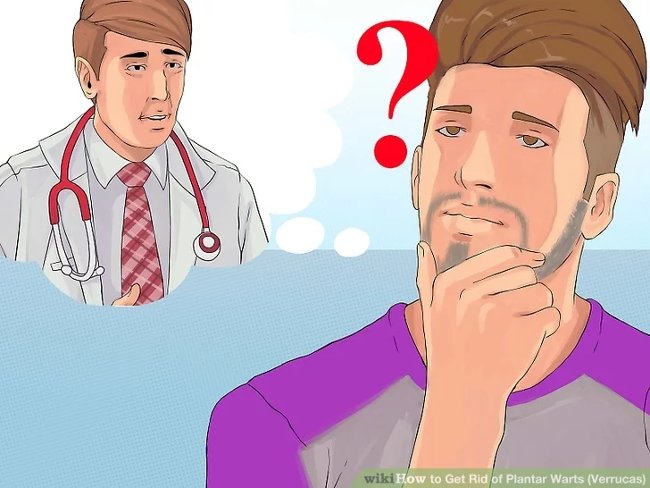
Although foot warts can be treated at home, there may be cases where a doctor's care is needed. Please seek medical advice immediately if you have the following complications:
- Warts do not go away after home treatment or disappear but return quickly.
- Warts grow larger or form clusters. This can be Mosaic warts ( warts that form small clusters under the soles of the feet or heels ).
- Warts start to bleed or feel more painful after treatment.
- Warts become swollen or begin to discharge. It is a sign of infection.
- If you have diabetes, have peripheral vascular disease or coronary artery disease, do not treat warts at home, you must go to a podiatrist to monitor blood supply from peripheral blood vessels to your feet, copper Time to treat warts. Because these conditions can increase the risk of infection or tissue death due to poor blood circulation.
Method 2: Ask your doctor to treat foot warts
1. Talk to your doctor about stronger skin peeling acid
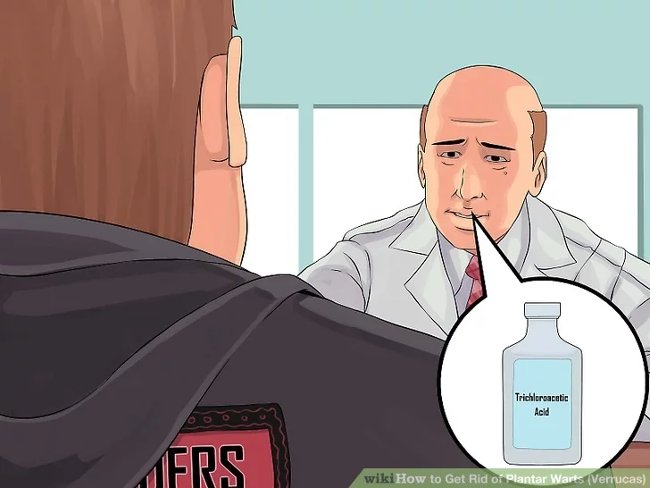
Over-the- counter salicylic acid is a skin peeling agent used to reduce the size of warts. However, when home treatment is ineffective, the doctor may prescribe stronger peeling acid such as bichloracetic acid or trichloroacetic acid . For treatment, you may need repeated treatments and your doctor may require additional salicylic acid at home.
2. Talk to your doctor about cooling therapy
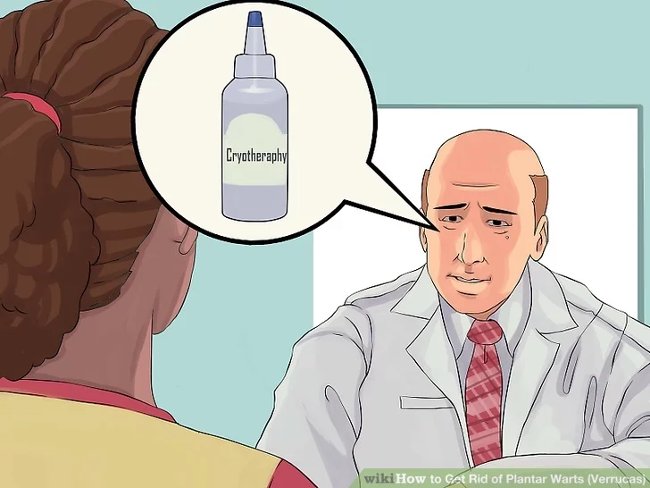
Similar to home-based freezing compounds, cryotherapy uses liquid nitrogen to freeze warts. After treatment, vesicles will form, heal, then peel off from the skin, carrying all or part of the warts.
- Cooling therapy can be painful and is often not used in young children . Your doctor may use a local anesthetic, depending on the size of the warts.
- When treated with cooling therapy, you need to see a doctor many times to see the effect.
3. Talk to your doctor about laser treatments
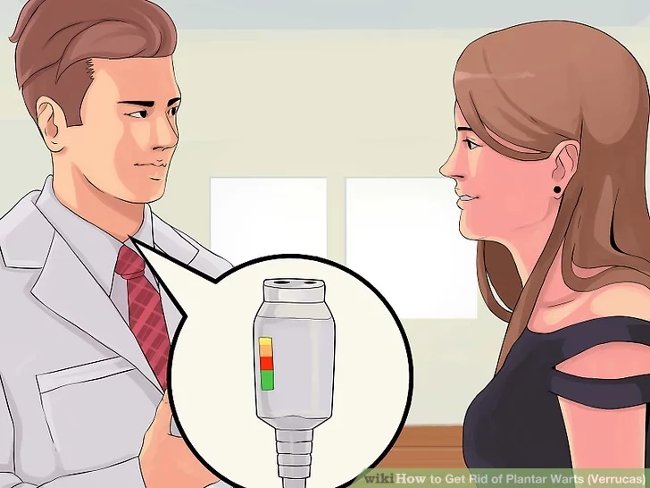
There are two processes that use lasers to remove warts: first, the laser cuts warts from the skin, and the laser burns blood vessels that carry blood to the warts and kills the warts.Laser surgery can be painful and take a long time to heal. Patients may receive local anesthetic and discharge immediately after surgery.
4. Talk to your doctor about immunotherapy
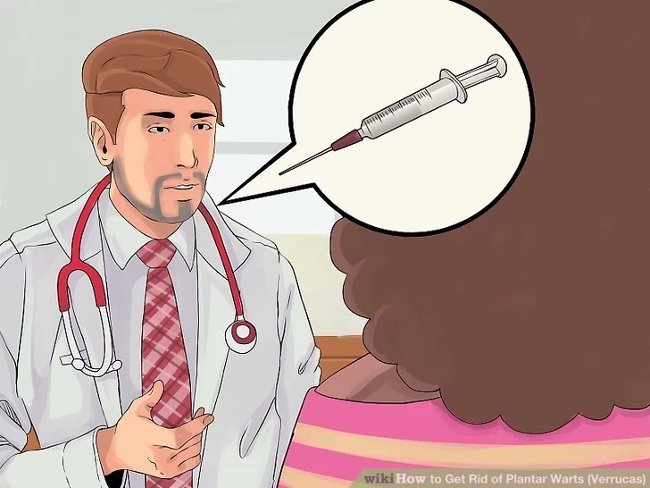
In this immunotherapy, your doctor will give you an injection of an antigen into your warts. In other words, the doctor will inject toxins into the wart to stimulate the immune system to fight the virus. This method is used for cases of warts that are difficult to cure or resistant to other treatments.
5. If you have not treated the warts, you can talk to your doctor about the surgery
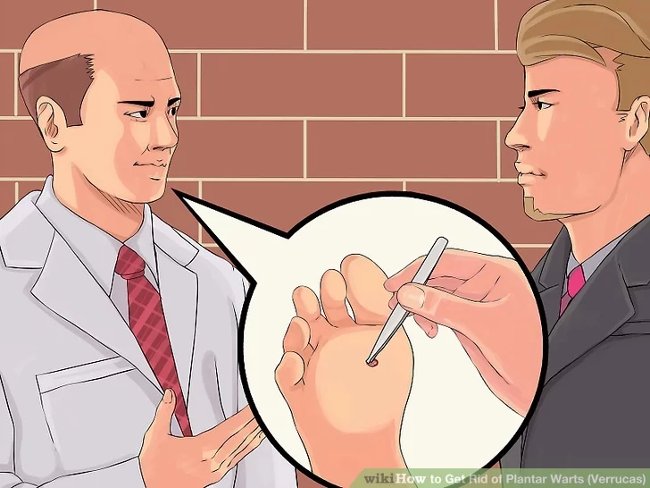
Foot specialists can use warts to remove warts by using a needle to destroy tissue around the warts and remove warts completely. This procedure can cause pain and leave scar tissue but is effective and delivers long-term results.
- ABSOLUTELY DO NOT cut the warts at home . By cutting the warts at home can cause bleeding and infection if not used properly and in a sterile environment.
Method 3. Determine and prevent foot warts
1. Determine the risk of foot warts
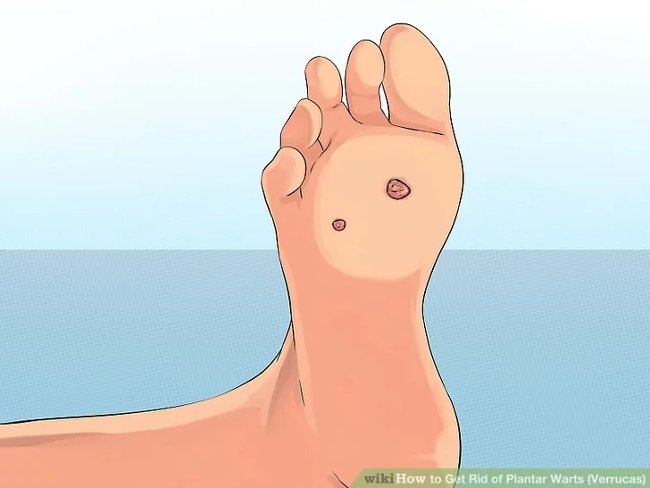
Warts are caused by contact with Human Papillomavirus ( HPV ). There are more than 120 different strains of HPV but only 5-6 strains cause foot warts. The virus invades through contact with infected skin scales.
- Athletes washing in public places have a high risk of foot warts due to many people and often do not protect their feet. For example, swimmers ( both indoors and outdoors in the summer ) are at high risk of foot warts if using public baths and walking around the pool. Besides, this risk is also high for people sharing a locker room in a gym, shower room, hot tub area - where many people walk with bare feet.
- Cracked skin or peeling skin will allow the virus to enter the body. Wet feet or sweating throughout the day are also at high risk of being exposed to excessive moisture, increasing the risk of viruses entering your body.
- People with foot warts have a high risk of relapse. Squeezing / squeezing warts can easily spread the virus to other parts of the body.
- People with weak immune systems due to illnesses such as infectious mononucleosis, Epstein-Barr virus infection, cancer, cancer treatment, people treated for psoriatic arthritis or HIV / AIDS infection.
2. Observe the location of suspected foot warts
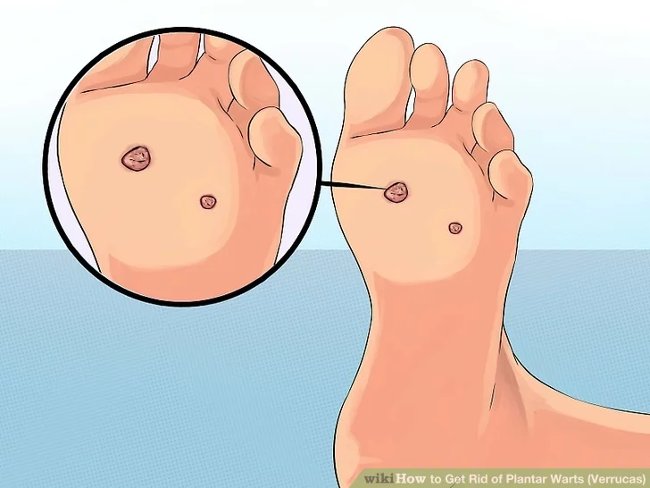
It may be a small, hard and flat skin, rough surface and a border around it. Although like a lumpy callus, foot warts are caused by infection. There are 2 types of foot warts: single warts or clustered warts ( Mosaic foot warts ).
- Single acne will increase in size and multiply into many single warts that radiate from the original warts.
- Mosaic warts are clusters of warts that grow together ( no skin in the middle ), do not grow, but grow close together, like large warts. Mosaic warts are harder to treat than single warts.
3. Evaluate secondary symptoms
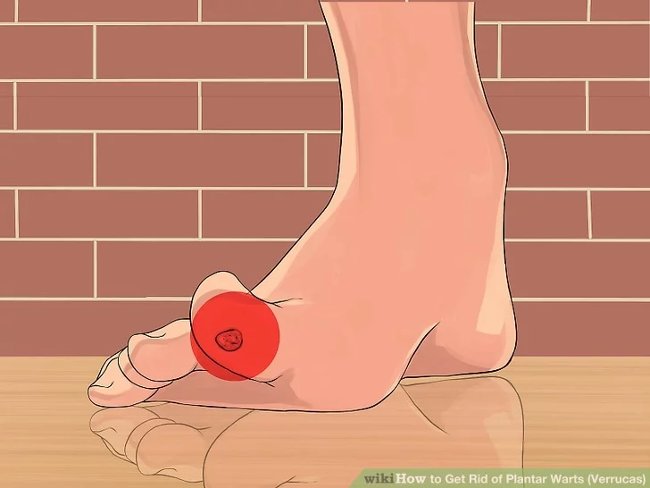
Are foot warts painful? Although like a callus lump under the soles of the feet, warts often cause pain when standing up and when friction. Watching the black spot inside the thick skin, it is called the ' warts ' but is actually small blood vessels stuck in the warts.
4. Careful warts spread
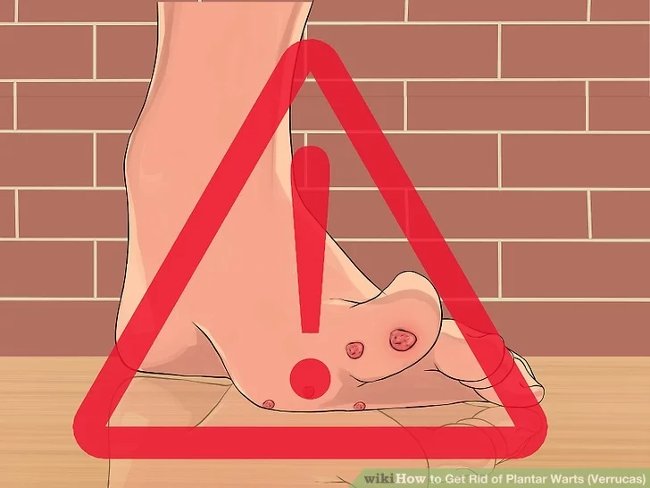
Warts can spread from person to person and spread to your own body. 3 small warts can quickly spread into 10 warts and are very difficult to treat. Like most other diseases, warts that are detected and treated early will eliminate more effectively.
5. Prevent new warts
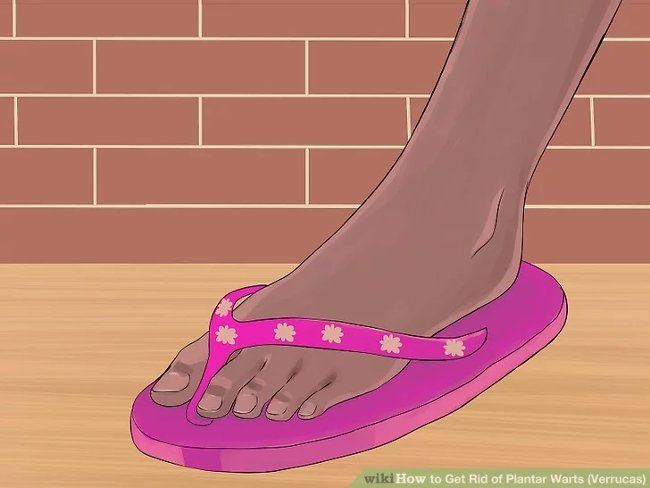
After treatment, you are at higher risk of getting HPV, resulting in new warts. To prevent, you should:
- Wear slippers or waterproof shoes in public places, bathrooms, dressing rooms, saunas, swimming pools or public hot tubs.
- Always keep your feet clean.
- Replace socks every day and use powder to keep your feet dry in case your legs are sweating profusely.
- Apply coconut oil on your feet at night before going to bed to prevent chapped skin and skin peeling. Remember to wear socks after rubbing coconut oil on your feet.
6. Avoid spreading warts to others
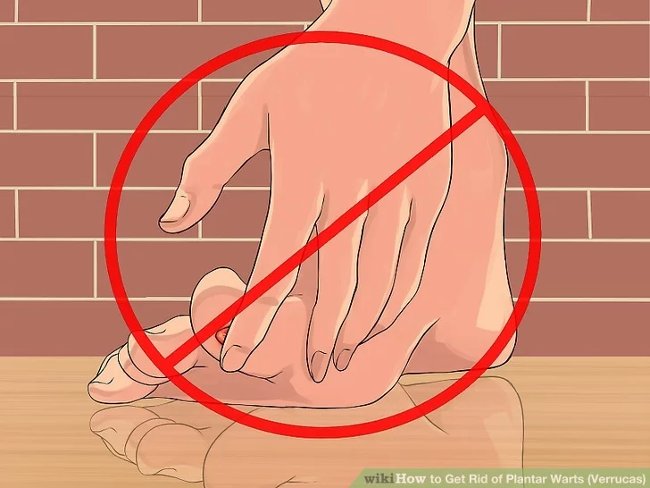
- Do not scratch or squeeze the wart to avoid infecting others or spreading other parts of the body.
- Do not touch other warts and do not use socks / shoes.
- Wear flip-flops or water-proof shoes when in the bathroom to avoid spreading warts to other family members.
- Do not leave clothes, towels and socks on the public changing room floor and pool area.
See also: How to remove acne effectively in just 1 day
Having fun!
You should read it
- 5 treatments for effective natural dry coughs you may not know
- 11 treatments for children to stop using antibiotics
- Notes with foot soak treatment
- Find new ways to treat breast cancer
- Mix foot soak to eliminate bad smell and prevent leg fatigue effectively
- Coronavirus treatments: Chloroquine, vaccines and the drugs fighting COVID-19
- The US FDA is experimenting with treatment of Covid-19 with anti-malarial drugs and human cures
- Solution for treating athlete's foot
May be interested
- '4-7-8' method helps you quickly get a good night's sleep as a child
 skinhead, trouble sleeping? this trick will solve it all, when you put yourself to sleep within 60 seconds.
skinhead, trouble sleeping? this trick will solve it all, when you put yourself to sleep within 60 seconds. - The proven benefits of eating spicy food are good for health
 spicy dishes from turmeric, ginger, garlic ... have many health benefits. for example, eating spicy helps to live longer, helping to enhance metabolism. if you haven't eaten spicy, you should try it soon.
spicy dishes from turmeric, ginger, garlic ... have many health benefits. for example, eating spicy helps to live longer, helping to enhance metabolism. if you haven't eaten spicy, you should try it soon. - Gas poisoning of ammonia, murderers in minutes
 if inhalation of ammonia is highly concentrated, the victim may burn the nasal mucosa, throat, respiratory failure and may die within a few minutes if not timely emergency.
if inhalation of ammonia is highly concentrated, the victim may burn the nasal mucosa, throat, respiratory failure and may die within a few minutes if not timely emergency. - Turn on the air conditioner, do you need a curtain before going to bed?
 most people don't get screened when they go to bed if they turn on the air conditioner in the room. because they think that mosquitoes like the hot and humid environment, they just turn on the cool air conditioner, the mosquitoes can no longer attack people. is this really true?
most people don't get screened when they go to bed if they turn on the air conditioner in the room. because they think that mosquitoes like the hot and humid environment, they just turn on the cool air conditioner, the mosquitoes can no longer attack people. is this really true? - Misconceptions when eating shrimp that many people have
 but many people do not know that, in some cases, eating shrimp does not bring about the same good results as we think, not even good for health.
but many people do not know that, in some cases, eating shrimp does not bring about the same good results as we think, not even good for health. - Shocking experiment about damage to the lungs and throat when you smoke a pack of cigarettes
 when you smoke, the smoke contains toxic substances that will stick to your throat and lungs, causing them to turn brown.
when you smoke, the smoke contains toxic substances that will stick to your throat and lungs, causing them to turn brown.






 Mix foot soak to eliminate bad smell and prevent leg fatigue effectively
Mix foot soak to eliminate bad smell and prevent leg fatigue effectively 4 ways to remove hair at home with natural ingredients
4 ways to remove hair at home with natural ingredients How to cure tongue burns after eating hot food
How to cure tongue burns after eating hot food Buy the best foot massage basin?
Buy the best foot massage basin? How to treat some diseases of the feet
How to treat some diseases of the feet